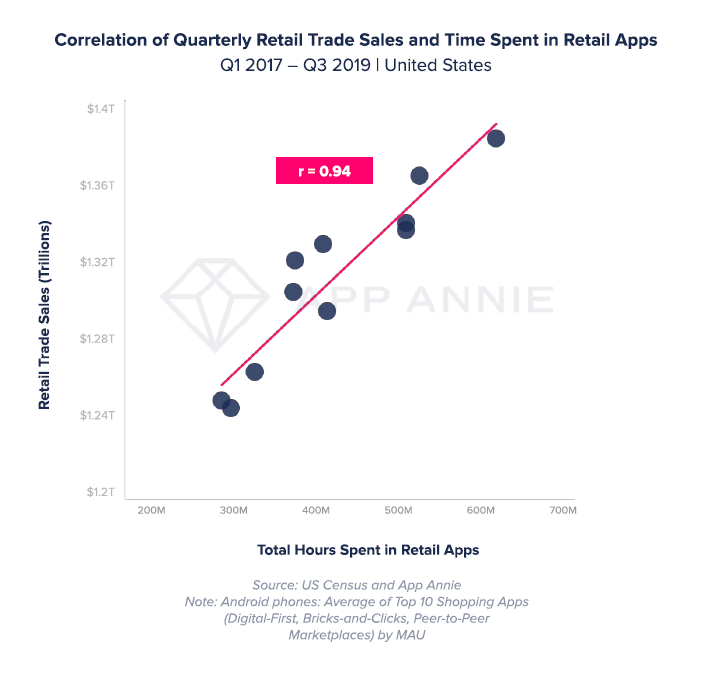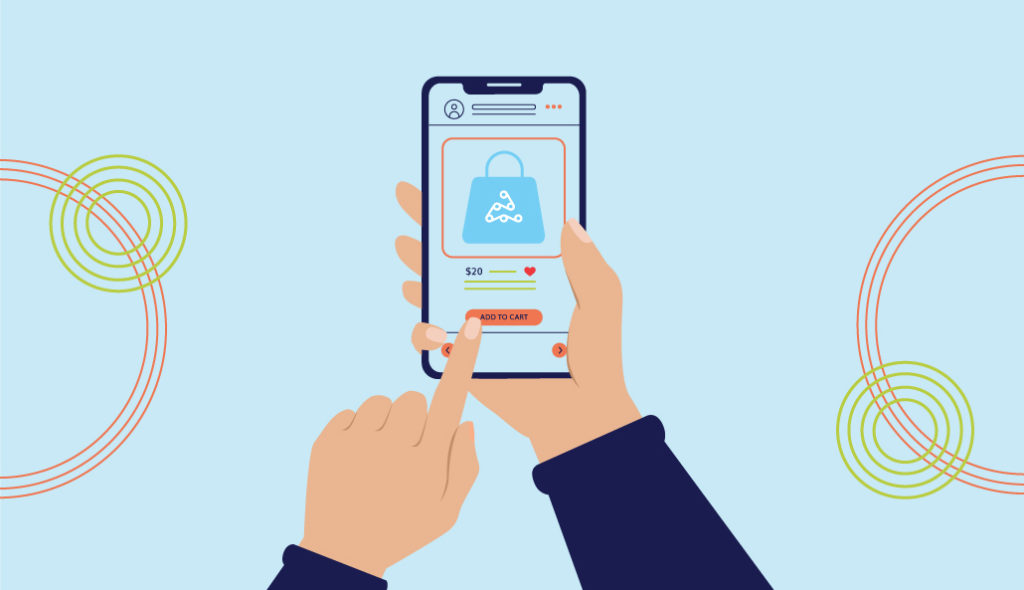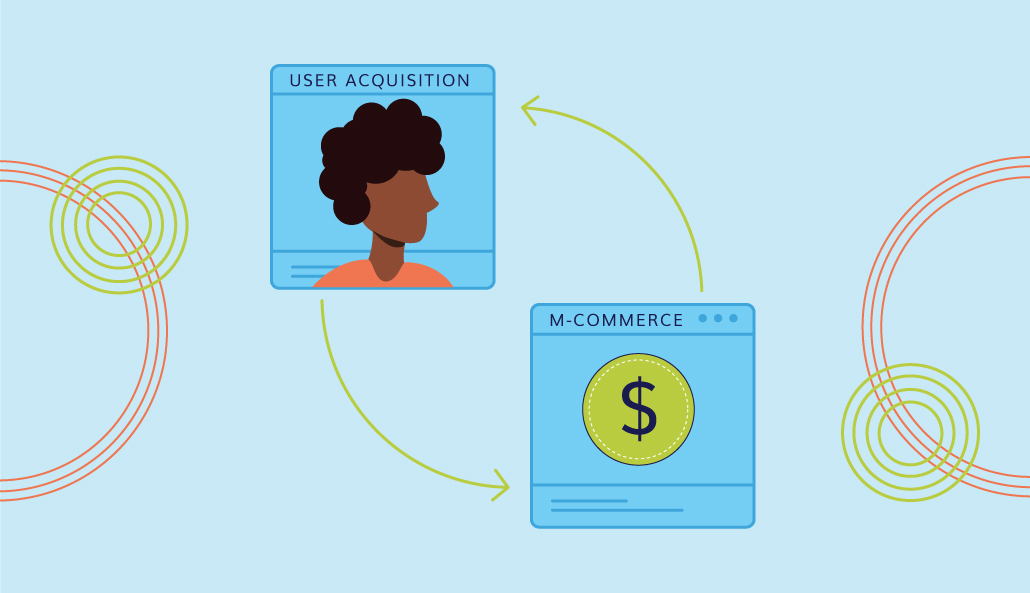There’s no doubt that e-commerce adoption is stronger than ever. However, e-commerce isn’t one thing. It includes purchases on desktops, mobile devices, and m-commerce apps. M-commerce is gaining steam, accounting for 31% of e-commerce sales in the U.S., which translates to billions of dollars.
But why would retailers care where their customers make purchases?
Time on Mobile Shopping Apps Correlates to Greater Sales
Mobile is significant for omnichannel growth. It’s not just about the purchases because mobile drives the research and consideration aspects of shopping. Data shows a strong correlation between total retail sales (online and in-store) and time spent in the shopping app.


Image: App Annie
With more time on these apps, retailers are investing in better experiences across the buying journey. In turn, that can drive brand loyalty and trust.
M-Commerce App Downloads and Time Spent in Them Up in 2020
2020 saw record-breaking numbers on downloads and time spent on them for obvious reasons. It was the biggest mobile shopping year to date, with significant gains during crucial periods. For example, U.S. shoppers spent over $74 billion via m-commerce from November 1 – December 31, 2020. Growth here outpaced desktop usage.
Customers also spent more time on shopping apps in 2020, growing by 45% year-over-year (YoY).
Shoppers Using Mobile Apps Deliver More Data
Overall, it’s easier to collect first-party data within your own app. Those using apps are more likely to have an account and login. Thus, a company can gather substantial data about that specific consumer, enabling them to personalize offers and hopefully increase spend.
Consumers Usually Prefer the User Experience on an App
Shopping on a mobile website isn’t always the best experience, even though everything is either responsive or a mobile-first design. There are just certain features, views, or other elements that work better in an app. If you provide a better experience for a user during their shopping journey, they’ll come back.
With integrations with chatbots, customers may also find it easier to get service when they need it in an app.
They appreciate the convenience in the app, both with usability and because they previously stored their preferences. Much of the time, it’s faster, and they may receive special rewards or better deals in the app.
With these data points, you can easily see why m-commerce app adoption should be a priority, but what’s the best way to do this?
User Acquisition Strategy Best Practices for M-Commerce


There are numerous options for user acquisition (UA) campaigns. You can use multiple options that integrate to drive a volume and quality users. There are several types of users you’re trying to appeal to here:
- Those that shop on your mobile website that you’d like to transition to the app.
- Consumers not currently shopping online.
- New customers that have never purchased from your brand.
These are three different segments, and they’ll all need specific strategies.
Converting Mobile Shoppers to App Shoppers
These consumers may be the easiest to convert, although that’s not an absolute. You have a lot of data on these people because of their online interactions with your brand, including preferences, purchases, and demographics. You’ll want to go with rewarded ads here, which means if they install the app, they get something of value.
Offerwalls are a good option, as they are non-intrusive ad units. They access these via traffic drivers. They enable cost-effective UA at scale, too. Be sure to use benefit-driven language in these initiatives, so you can finally get that user to say yes to your app.
Getting In-Store Shoppers Online
First, keep in mind that just because they don’t shop online with your company doesn’t mean they don’t at all. So, what may be holding them back?
Consider the retail segment of grocery stores. As we know, grocery e-commerce skyrocketed during the pandemic. It was an organic adoption but forced by necessity. That’s an outlier, but you can learn from this. What it comes down to is convenience. If a customer only shops in your store, they may think that shopping on your app won’t be a good experience. So you have to convince them otherwise.
While you could do this with in-store signage or even messages on receipts, you can expect most to ignore them. Where they may not, is online.
You’ll want to work with a reward ad platform that can help you plan out CPI (cost per install) campaigns to target these customers. You do know something about them based on POS data, loyalty cards, or other data collected in-store. So, you know their location and possibly even have their email and phone number.
By choosing a reward platform that has access to thousands of sites and app placements, you can ensure that you reach those in this segment.
Acquiring First-Time Customers to Your App
If a consumer has a specific purchase need, they start with a search, whether on Google or in the app store. You can deploy ads on these channels to guide shoppers to download your app. But before we talk about those ads, you’ll want to focus on app store optimization (ASO) for your e-commerce app.
Before you launch any campaigns, make sure your app profiles appeal to this audience, specifically by changing up language in descriptions or imagery. Also, if you want to win new customers, you need to keep an eye on your rating. If it’s decreasing, you may want to spend time to improve it so that users see your brand as credible and reliable.
Once your profiles are optimized, you can launch ads through search engine marketing (SEM) or on app stores. These ads should speak to the specific, assumed needs for that segment. Be sure they understand what your app can provide—easier checkout, deeper discounts, etc.
In addition to search ads, you can also launch burst campaigns around keywords and categories. These are concentrated, aggressive ad spends that drive a high volume of installs. As more people download from these rewarded ads, your app rank can climb as well, offering even more visibility.
AdAction Supports M-Commerce App UA in Every Way
UA is going to look different as you attempt to get more users on your retail app. We broke it down into three segments, but you may have even more you want to target. And we can help. We’ve got solutions to fit your specific requirements. Connect with our app marketing experts today to learn more.


